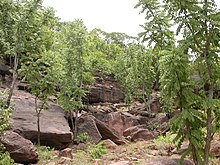| Pericopsis laxiflora | |
|---|---|

| |
| Scientific classification | |
| Kingdom: | Plantae |
| Clade: | Tracheophytes |
| Clade: | Angiosperms |
| Clade: | Eudicots |
| Clade: | Rosids |
| Order: | Fabales |
| Family: | Fabaceae |
| Subfamily: | Faboideae |
| Genus: | Pericopsis |
| Species: | P. laxiflora |
| Binomial name | |
| Pericopsis laxiflora (Benth. ex Baker) Meeuwen | |
Pericopsis laxiflora is a woody deciduous shrub or tree within the Fabaceae family. Sold commercially as satin wood, it is known in some regions as Kulu Kulu, among the Hausa speaking people, it is called Makarfo, the Yorubas call it Ayan and the Igbos call it Abua-Ocha. It is one of three species in the genus Pericopsis genus that occurs in Africa.
The species contains the alkaloids: N-methylcytisine, ammodendrine, and choline.
Description
A tree or shrub, common growth reaches between 9 and 12 meters tall but occasionally grows up to 2 meters tall as a shrub. Trunk usually twisted, rarely straight and with twisted branches, bark is smooth, grey to beige in color while stem is pubescent. Leaves, alternate arrangement, 4–6 pairs, upper surface imparipinate, shiny and lower surface glabrous. Leaf-blade, lanceolate to ovate in outline, 3–7 cm long and 2.5–5 cm wide, acuminate apex with cuneate base. Petiole, 15–20 cm long.
Distribution
Occurs widely in the Savannah and dry forest regions of West Africa.
Uses
Root, bark, leaf decoctions are used to treat stomach ailments in Côte d'Ivoire, while in Guinea, plant extracts are used to treat shigellosis. In Ghana, it is used as a topical treatment for body pain and among some locals in Cameroon, the plant extracts are used by diabetes patients.
References
- Fitzgerald, Maurice A.; Gunning, Peter J. M.; Donnelly, Dervilla M. X. (1976). "Phytochemical examination of Pericopsis species". Journal of the Chemical Society, Perkin Transactions 1 (2): 186–191. doi:10.1039/p19760000186. ISSN 0300-922X.
- Tringali, Corrado (1995). "Identification of bioactive metabolites from the bark ofPericopsis (Afrormosia) laxiflora". Phytochemical Analysis. 6 (6): 289–291. doi:10.1002/pca.2800060603.
- Fadipe, L. A.; Babayi, H.; Anselm, O. A. (2019-12-14). "Isolation and in-vitro assessment of two indole alkaloids from Pericopsis laxiflora leaf extract for their antibacterial potentials". Journal of Chemical Society of Nigeria. 44 (7). ISSN 0795-2066.
- Forestieri, A. M.; Monforte, M. T.; Ragusa, S.; Trovato, A.; Iauk, L. (1996). "Antiinflammatory, Analgesic and Antipyretic Activity in Rodents of Plant Extracts used in African Medicine". Phytotherapy Research. 10 (2): 100–106. doi:10.1002/(SICI)1099-1573(199603)10:2<100::AID-PTR724>3.0.CO;2-I. ISSN 1099-1573. S2CID 84307919.
- ^ Arbonnier, Michel; Arbonnier, Michel (2004). Trees, shrubs and lianas of West African dry zones. CIRAD. p. 321. ISBN 978-3-8236-1419-7. OCLC 249767040.
- Haruna, A. K. (2000). "Depressant and anticonvulsant properties of the root decoction of Afrormosia laxiflora (Leguminosae)". Phytotherapy Research. 14 (1): 57–59. doi:10.1002/(SICI)1099-1573(200002)14:1<57::AID-PTR538>3.0.CO;2-V. ISSN 1099-1573. PMID 10641052. S2CID 6833059.
| Taxon identifiers | |
|---|---|
| Pericopsis laxiflora |
|
| Ormosia laxiflora | |